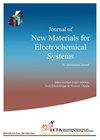Pitting Corrosion and Mechanical Properties of Direct Current and Pulsed Reverse Current Electrodeposited Nickel-Tungsten Coatings
IF 0.6
4区 材料科学
Q4 ELECTROCHEMISTRY
Journal of New Materials For Electrochemical Systems
Pub Date : 2022-06-10
DOI:10.14447/jnmes.v25i2.a06
引用次数: 0
Abstract
The electrochemical corrosion and mechanical properties of direct current and pulsed reverse current electrodeposited nickel and nickel-tungsten were investigated by using cyclic polarization measurement and nano-indentation techniques. Direct and pulsed reverse current electrodeposited nickel-tungsten coatings revealed a significant higher resistance to pitting corrosion when compared to direct and pulsed reverse current deposited nickel. Furthermore, pulsed reverse current electrodeposited nickel-tungsten displayed the most noble corrosion potential and higher corrosion resistance compared to direct current electrodeposited nickel-tungsten. This was attributed to the more nano- crystalline structure of the pulsed-reverse current deposited coatings when compared to that of the direct current electrodeposited nickel-tungsten. The average modulus for both direct and pulsed reverse current deposited nickel-tungsten were found to be similar but the average hardness of direct current deposited nickel-tungsten was slightly higher than that of pulsed reverse current deposited nickel-tungsten. This was attributed to the higher tungsten content (35 wt.%) in the direct current deposited nickel-tungsten coating compared to that (25 wt.%) in the pulsed reverse current deposited nickel-tungsten and is supported by our energy dispersive X-ray spectroscopy results.直流和脉冲反向电沉积镍钨镀层的点蚀和力学性能
采用循环极化法和纳米压痕法研究了直流电和脉冲反向电沉积镍和镍钨的电化学腐蚀和力学性能。与直接和脉冲反向电流沉积的镍相比,直接和脉冲逆向电流电沉积的镍-钨涂层显示出显著更高的耐点蚀性。此外,与直流电沉积镍-钨相比,脉冲反向电沉积镍钨显示出最高尚的腐蚀潜力和更高的耐腐蚀性。这归因于与直流电沉积的镍-钨相比,脉冲反向电流沉积的涂层具有更多的纳米晶体结构。发现直流和脉冲反向电流沉积的镍-钨的平均模量相似,但直流沉积的镍钨的平均硬度略高于脉冲反向电流沉淀的镍-钨丝的平均硬度。这归因于直流沉积的镍-钨涂层中的钨含量(35wt.%)高于脉冲反向电流沉积的镍钨涂层中钨含量(25wt%),并且我们的能量色散X射线光谱结果支持了这一点。
本文章由计算机程序翻译,如有差异,请以英文原文为准。
求助全文
约1分钟内获得全文
求助全文
来源期刊

Journal of New Materials For Electrochemical Systems
ELECTROCHEMISTRY-MATERIALS SCIENCE, MULTIDISCIPLINARY
CiteScore
1.90
自引率
0.00%
发文量
33
审稿时长
>12 weeks
期刊介绍:
This international Journal is intended for the publication of original work, both analytical and experimental, and of reviews and commercial aspects related to the field of New Materials for Electrochemical Systems. The emphasis will be on research both of a fundamental and an applied nature in various aspects of the development of new materials in electrochemical systems.
 求助内容:
求助内容: 应助结果提醒方式:
应助结果提醒方式:


